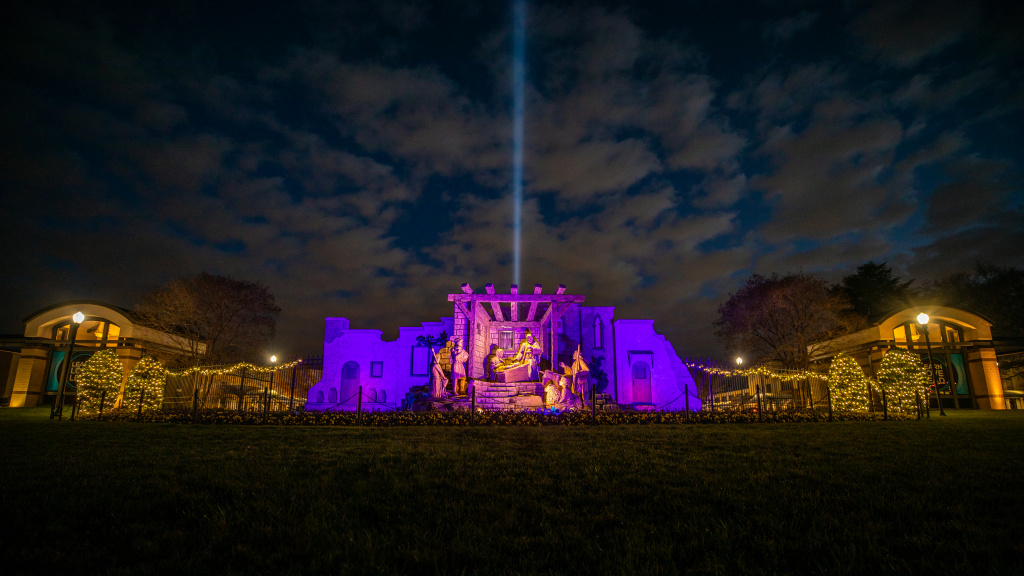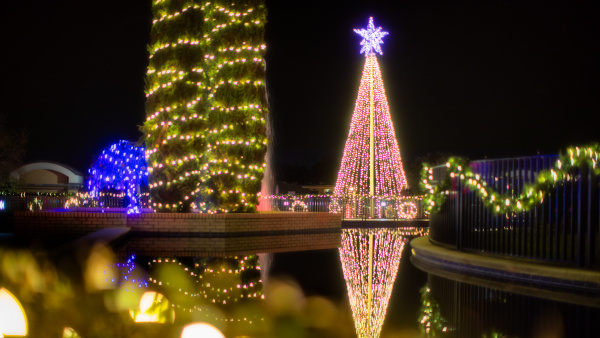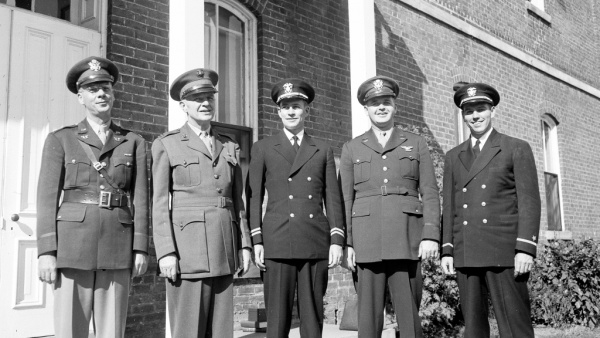“It’s up a month, and it’s made out of styrofoam, but it actually speaks to more people (than my other sculptures), and I get so much emotional response,” said artist Doug Young about the crèche he created for BJU’s front entrance.
According to the Oxford English Dictionary, a crèche is “a nativity scene, often displayed at Christmas, consisting of a representation of the infant Jesus in the manger, with attending figures.”
The University’s crèche is not only a highlight for the BJU community but also for the Greenville community as a whole. Said Young: “One of my favorite stories of two or three years ago, we were out at the lighting ceremony, and a woman said, ‘Are you the guy who did this?’ And I said yes.” The woman told Young that they lived near the campus and her little girl couldn’t go to bed without coming to say good night to the baby Jesus.
Harrell Whittington and Beneth Jones’ Crèche
BJU’s first nativity scene was designed by stage scene designer Harrell Whittington and director Beneth Jones as the set for the 1994 Christmas Vespers. “She wanted to bring out the idea of the cross behind the nativity,” said Whittington. “So, it was made transparent with hardware cloth … and some fiberglass strands were strung over it to catch the light.” In addition to the Holy Family, the scene included mesh angels. Added Whittington, “It was made so that during the progress of the scene the red cross would show up through it.”
Jason Waggoner, stage scene designer, said, “I’ve actually worked on all the crèches for whatever reason. (The first one) was sort of translucent … then it had this fiberglass stuff stuck to it, which sounds really ugly, but in the end when it’s spray-painted gold and it’s farther away, (the fiberglass) gives it a glow.”
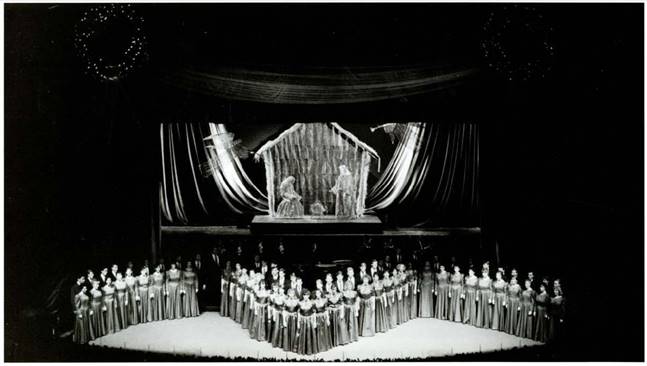
After the Vespers performance, Bob Jones III enjoyed the nativity scene so much, he requested it be placed on the roof of the Rodeheaver lobby the next year. Lighting designer and technical director for Rodeheaver stage Rich Streeter, who has also worked on all four crèches, said of the first, “It had to be reconfigured some. … (Putting it on top of Rodeheaver) seemed like such a pain to do. But now it seems like that one was so simple.” The crèche has been a part of the University’s holiday decorations since, and each of the following scenes has increased in detail and complexity.
Jason Waggoner’s Crèches
Designed by Jason Waggoner about 2002, the second crèche required some assembly once placed atop Rodeheaver lobby, unlike its predecessor which was a one-piece set. Streeter said the facilities department would bring a large forklift to lift the pieces to the roof for the crew to assemble. Thankfully, he said, “That roof wasn’t as tall as the one now.”
Waggoner said, “I designed these figures pretty stylized, very monochromatic. … Close up (the figures look) kind of rough, but very stylized. They were only meant to be seen really from one or two angles.”
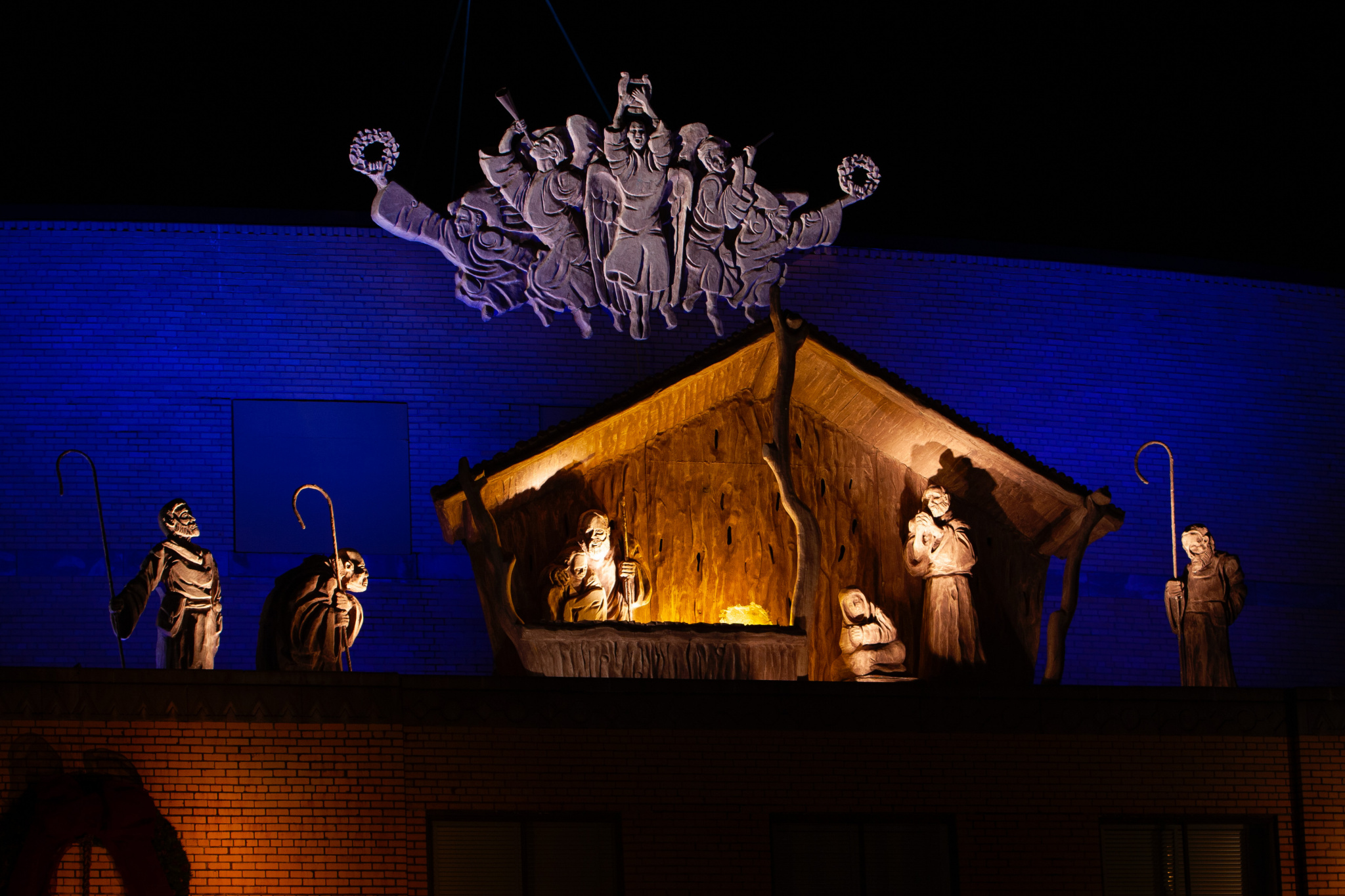
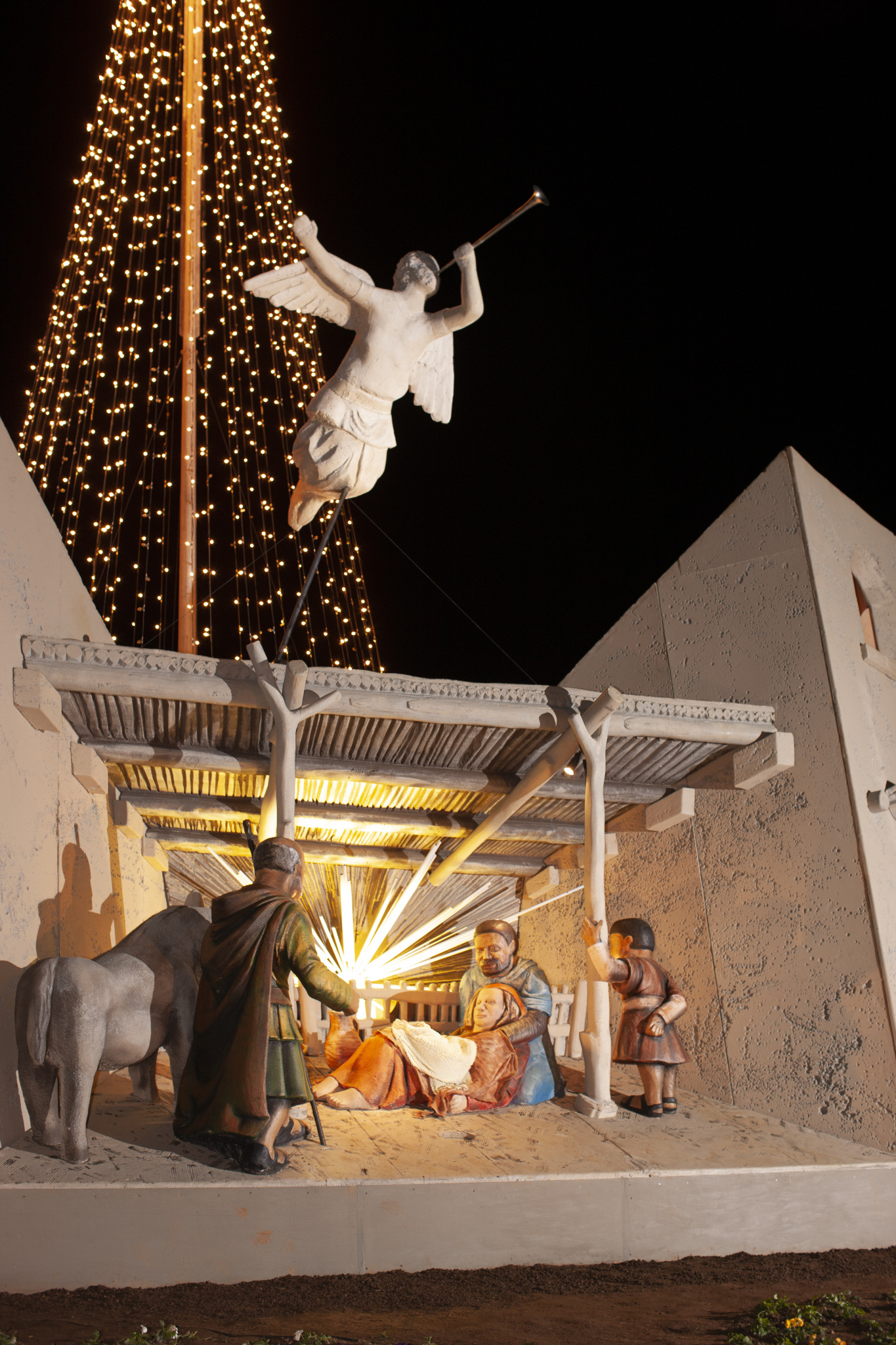
Waggoner’s second design, installed in 2008, was the first to relocate to the lawn between the front campus gates. That year, the lobby of Rodeheaver Auditorium was remodeled and was now too tall to host the crèche.
Since its new location was larger, the new design was also much larger. In Streeter’s words, “It was huge.” Though the architecture was stylized as Waggoner’s previous design was, the characters were more realistic. “This was the one that I felt like I really got to design. I really enjoyed the process,” Waggoner said.
Doug Young’s Crèche
Local artist and BJU alumnus Doug Young designed the current crèche installed at the front entrance in 2011. “Doug had just then begun to really get into sculpture,” said Waggoner. “He had been doing it a little for a little while, but he was really stepping out in faith as a sculptor as opposed to working a day job. And so it was a great opportunity for him, and I think he did a great job. It’s a very nice sculptural look that he does, that echoes his clay and wax work that he does on his other pieces.”
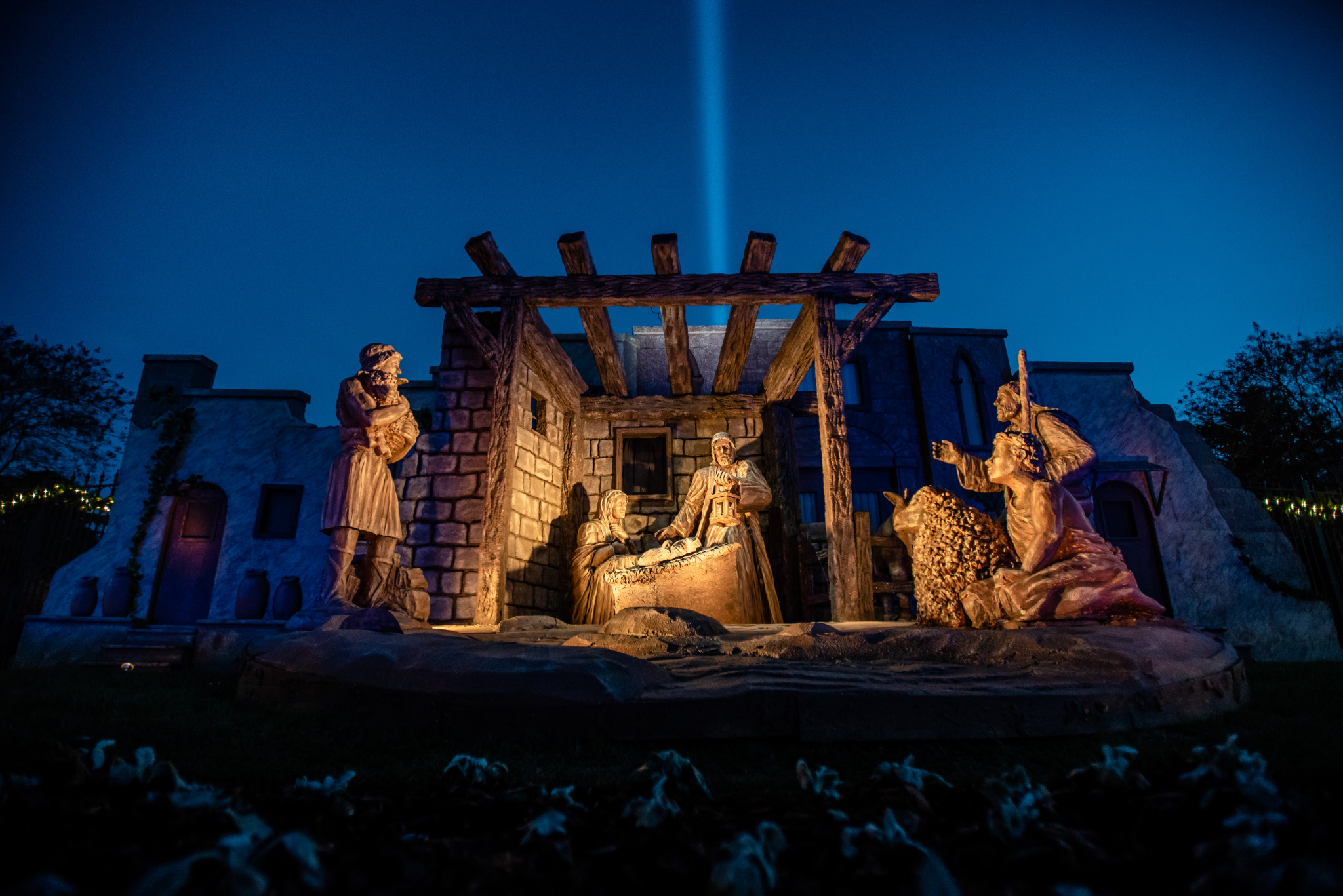
“One of the things I know that we wanted to do was keep it more a traditional look,” said Young. “You know, the shepherds with sheep and in clothing that might be appropriate to the time. The barn I was trying to keep open and airy, so you could see it’s just kind of a hint of a barn or a stable. So taking all those things, stable and everything, and then I wanted a backdrop of a cityscape behind it because I was hoping that would break the activities that are going on on campus.”
While Young did the artistic design and carving, Waggoner assisted with structural design. “I was helpful,” said Waggoner, “but really he did all the work on it. He did a lot of drawings and stuff, and then I came behind him and did some of the structural design and some specific stuff we needed to just build things. I think I helped with the textures, the paint textures and approaches and stuff like that.”
Like Waggoner’s nativity, Young’s was also made of a combination of wood and a dense styrofoam. His process, however, begins on paper. “I did a couple of sketches, and then I did a small scale model,” said Young. “I did a small scale model out of styrofoam and got the figures and tried to keep it to scale so that we would know how high it’s going to be. And then (stage crew) could measure from there and say yeah that’s going to work or this is not going to work. … (Then) I carved all the figures — some of those figures are almost 7 feet tall — and I carved them all in my studio.”
Last year, the foreground of the scene was showing signs of breaking down. So Waggoner and Young worked on a redesign of the crèche rather than rebuilding the existing set. Said Waggoner: “One of my goals with the redesign was (give the manger scene more attention). I felt like the background took over a little bit. So, we raised it up, and we made it a little more visually present, and we changed the structure of it so that we could get a little more visual focus into the manger.”
Young said of the redesign, “(My previous design) was also cumbersome. So I came up with some ideas of how to build stairs and try to keep it in sections. But Jason and I worked on some ideas as to how to make it more feasible, more user friendly for stage guys who have to put it together. It’s also easier to store. So last year and this year, there are stairs. It’s also taller. It has more of a vertical thrust to it, whereas before it was pretty much eye level. I think that also works better from the street, too.”
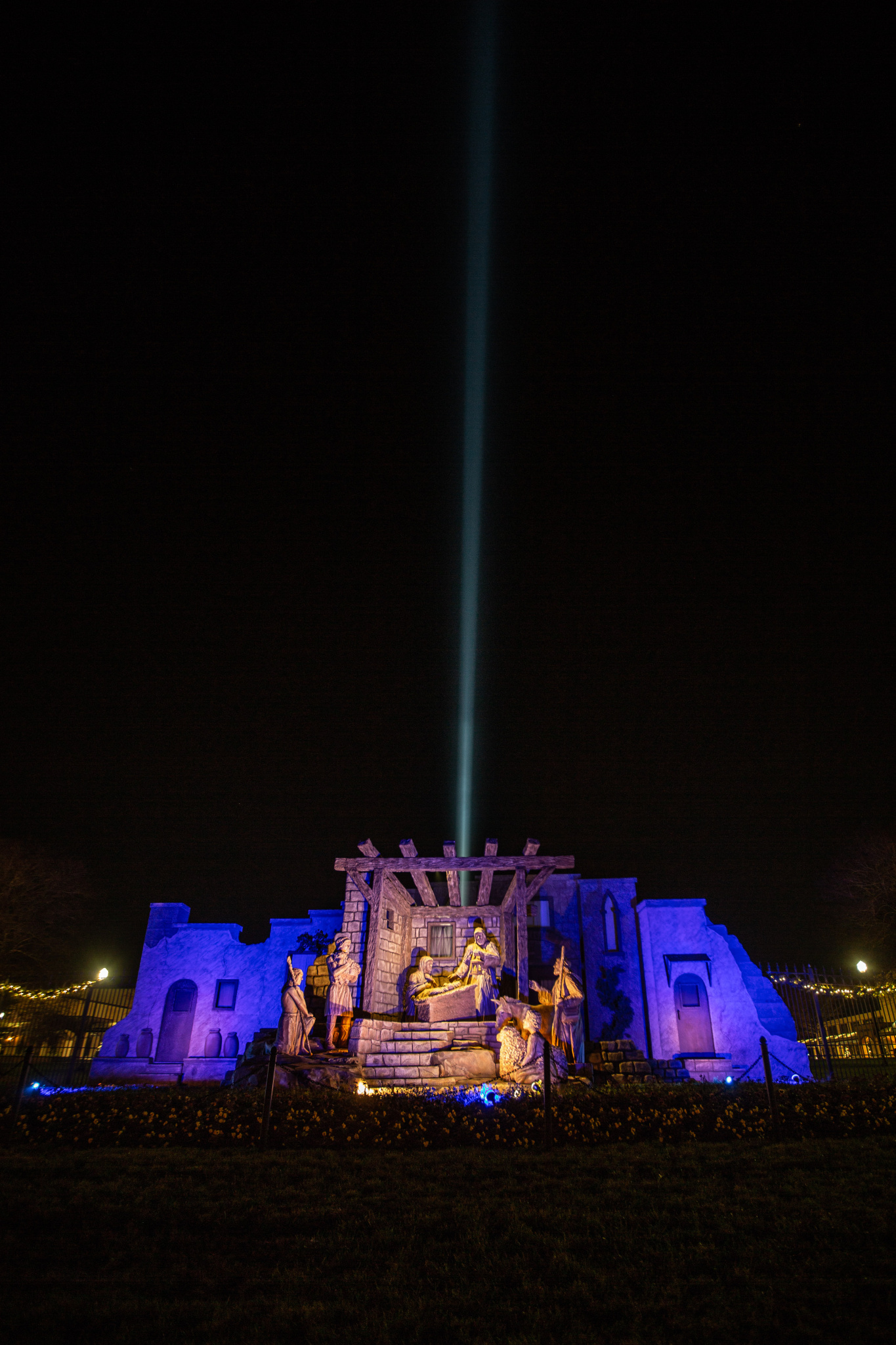
Multiple Designers, One Story
As with most artists, the designers of the University’s crèches each had a purpose for their designs. Beneth Jones wanted the cross of Christ to be seen through her and Harrell Whittington’s nativity, emphasizing the redemptive purpose of Christmas.
Young expressed surprise that more people favor his styrofoam nativity sculpture than his bronze sculptures. “It’s up a month, and it’s made out of styrofoam,” he said, “but it actually speaks to more people, and I get so much emotional response. … I just really want that human connection, and that’s what I was going for. That was my mission: to communicate the story of this Christ child and everyone coming to see the Christ child. Not that everyone did. It was also outside the city in a barn, and that’s why I want the cityscape, too, because on the other side there’s all kinds of activity. Inside, people came from everywhere, but outside the city, to the shepherd, it was good tidings of great joy.”
Waggoner said, “All crèches tell the same story — they all focus on Christ’s birth — but each one, each artist’s telling of that story, offers different details for viewers to consider. They’re not designed primarily as history lessons but as worship. Like other forms of worship, different believers at different times are struck by certain attributes of God. We rejoice in different aspects, but in one God who came at one time, for one reason. The artists get to rejoice as we design and create, but we hope the viewers rejoice with us because these pieces are — in the end — not just personal expressions, but service to the community around us.”


